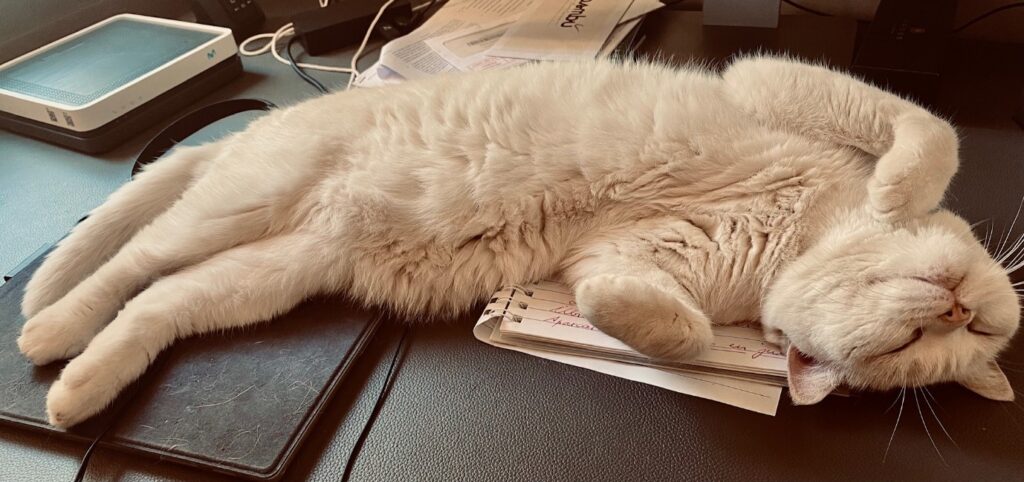In case you are engaged in a “hot dispute” in this hot summer, so as to “cool-off” a bit, this is to start a discussion about settlement options for pending litigation.

[A lawsuit taking a good long snooze …]
A recent decision of the Austrian Supreme Court (short “OGH”) dealt with the procedural impediment of lis pendens, which barrs the claimant from bringing a new lawsuit against the same defendant (OGH 29.03.2022, case 4 Ob 163/21f). While the case itself is mostly of procedural interest, the underlying practical question is how to best end a pending court proceeding in Austria in case of a settlement. Therefore, before I discuss the ruling of the OGH, let me give you a brief overview of how litigation can be terminated.
Once a lawsuit has been started and the writ has been served on the defendant, it cannot simply be withdrawn. So if the parties reach settlement after this point, here are the options:
- The claim can be withdrawn provided that (i) the Claimant renounces all claims that were subject to the lawsuit and pays all cost of the defendant, or (ii) the defendant consents and the parties agree on costs. This option is sometimes chosen if the case is clear, or if the defendant has not yet filed a response and wishes to avoid the cost of that.
- Alternatively, the parties can conclude a formal settlement in an oral hearing. In that case the Court will issue a settlement copy, which gives the claimant a legally enforceable title, should the Defendant not comply with the terms of the settlement.
- Sometimes, however, the parties in a trademarks (or other) legal dispute reach an out-of-court settlement, but decide not to formally conclude the pending infringement proceedings in line with these options. In that case, parties frequently agree on an informal “stay” or “Ruhen” of the proceedings, that may be either a temporary (aka “simple”) or a perpetual dormancy.
The simple dormancy is governed by the Austrian Code of Civil Procedure (§ 168 ZPO): If the parties inform the Court of the dormancy, the proceedings are suspended for a minimum of 3 months, until one of the parties requests the scheduling of a hearing. Accordingly, the proceedings may be resumed later on. A “perpetual dormancy” is not provided for in the Code of Civil Procedure. Therefore, either party can request continuation after the expiry of the 3-month minimum period, even if this counteracts the settlement agreement. The Court then has to resume the proceedings. If one party submits that dormancy had been agreed, the Court must assess the agreement. If the Court concludes that the parties have effectively agreed a final settlement, it dismisses the lawsuit on the merits.
In practice, (perpetual) dormancy agreements are frequent. However, to get back to the recent ruling of the OGH, an important disadvantage of a dormancy agreement is that it does not formally end the legal proceedings and thus, the case remains “pending” (irrespective of the fact that the Court file will be archived and destroyed after 30 years at the latest).
Therefore, in the (albeit rather rare) case that the Claimant later wishes to bring a lawsuit against the same defendant concerning the same subject matter (e.g. if the agreement with the defendant was terminated for a reason), it will be blocked from doing so by the pendency of the action. As the OGH sets out, the pendency of a legal proceeding is only ended by a final dismissal of the lawsuit or final decision on the merits, a settlement in court or a withdrawal of the lawsuit.
Accordingly, beware of ending a pending litigation in Austria by a dormancy agreement if you are not 100% sure that the matter will not bounce back. If there is any doubt, it is better to formally end the infringement proceedings by a formal settlement, or a withdrawal of the lawsuit with the defendant’s consent, or to obtain a final decision.
_____________________________
To make sure you do not miss out on regular updates from the Kluwer Trademark Blog, please subscribe here.
Kluwer IP Law
The 2022 Future Ready Lawyer survey showed that 79% of lawyers think that the importance of legal technology will increase for next year. With Kluwer IP Law you can navigate the increasingly global practice of IP law with specialized, local and cross-border information and tools from every preferred location. Are you, as an IP professional, ready for the future?
Learn how Kluwer IP Law can support you.


